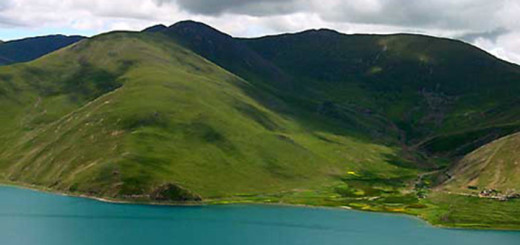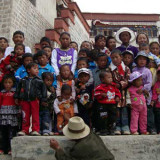Tibet 2007

General Environment
The living conditions in the villages on the Tibetan plateau are extremely difficult: at an altitude of 4000 metres the winters are freezing cold – temperatures can easily fall to -15/20 degrees -, the earth is hard and dry and the crops scarce.
Almost all the houses in the villages, built in stone or from mud bricks, are without windows in an effort to stop the winter cold from entering. There is no fuel for heating (trees are very rare) and the only materials available to burn are dried scrub and yak dung.
In the houses there is no running water and no electricity. There are no shops or postal service.
Due to the arid climate there is a dramatic lack of water, and often in these villages there are no water fountains.
Agriculture is the only means of livelihood, but the harvests obtained from this rocky earth during the summer months is not enough, above all because of the scarcity of water, for survival. There are no excess crops to sell, which means there is not even a minimal amount of money to be had to start any economic development or for buying necessities such as clothes, shoes, medicine and so on.
The villagers cultivate mainly barley, turnips and potatoes; in the villages there is no fruit or vegetables and as a result the cases of malnutrition caused by the lack of vitamins is very high. The diet consists mainly of tsampa, barley flour mixed to a paste with butter and salty tea, sometimes with a little dried cheese or meat added.
Shopping and Distribution
Towards the end of July the work of the Association’s volunteers started with shopping in the markets of Lhasa, the capital, where it is possible to find many different kinds of clothing. In the villages reached by the Association there are no shops, and anyway the income of the families is less than nothing so there is no possibility to travel into the city to buy basic essentials.
All the materials bought in Lhasa were loaded onto trucks and the convoy continued towards the city of Shigatse, the second largest city of Tibet, around where most of the villages and monasteries helped by the Association are situated.
In Shigatse the second phase of the shopping was carried out: 25kg sacks of flour, rice and ground barley, exercise books, pens, ink, pencils and erasers for the children attending school, personal hygiene items for all the children.
Again this year the arrival of aid was a moment of great joy in the villages: an event very eagerly awaited and increasingly important.
Unfortunately, it is three years that the rains in this region have been more scarce than usual; as everywhere else the average temperature on the Tibetan plateau also continues to rise, the glaziers are receding and the dry weather of the region worsens. In fact, this year, some of the villages had almost completely lost their harvests. With the arrival of the volunteers of the Association, other than the material help they receive, the children and their families understand that again this year they have not been forgotten, they have the knowledge that someone is thinking of them affectionately and acting to help them.
As in every other year, representatives from neighbouring villages requested to be inserted into the aid programme.
The work of the distribution, in the presence of local government representatives, was carried out according to the population census to guarantee an equal distribution between all the children of the villages and their families. This year every family received a precious stock of flour, rice and ground barley for the winter. Every child – now more that 2000 – received a winter jacket, sweater, trousers, woollen long-johns, shirt, socks, leather and canvas shoes; as well as the necessaries for personal hygiene: soap, towel, toothbrush and paste. The children attending school were given new school uniforms and a supply of exercise books, pens, ink and pencils to last them all year.
All the children were photographed, both those already sponsored and those still waiting, and many families wrote letters for their benefactors: very simple letters, often repetitive, that try to express their gratefulness and heartfelt thanks for the help that is sent from so far away. Some families received letters and photos from their benefactors, and for them it was the cause of immense happiness to meet even if only through an image. These images are rigorously saved as precious possessions, a kind of auspicious talisman that symbolises for them an important friendship.
Schools
Thanks to the donations collected the number of children attending school in the villages increases every year; without help it is very difficult for the families to confront school expenses when the harvest is often not even enough to feed the family for 5-6 months. The lack of excess crops to sell means that there is no income to buy school materials, clothes, shoes, medicine…
Thanks to the help of the Association the work on the new dining room wing and kitchen of Nye Village School – that hosts almost 500 children studying in classes I to VI – is completely finished. The majority of these 500 children have to live and sleep inside the school, because the smaller village schools only teach up to class III. The kitchen, which had become both unfit and inadequate for the growing number of children, is now in a new larger building and has been recently equipped with new steamers, pans, dishes and crockery; the dining rooms have also been decorated and fully furnished, and to promote better hygiene each child has their own set of cups, cutlery and plates.
Still functioning are the new schools built by the Association in the villages of Nepu and Pandin; these and other elementary schools in the region received help this year to buy school materials and to carry out frequently needed building repairs which are necessary thanks to the extreme climatic condition of the Tibetan plateau.
Nye Village Dispensary
Slowly, slowly the health situation is improving, thanks to the dispensaries built in Singma, Nepu and Nye and to the realisation of greenhouses to promote the cultivation of vegetables.
This year one of the Association’s supporters gave an important donation in memory of her parents. This donation permitted the construction, now close to completion, of a new wing to Nye Village Dispensary.
This dispensary, located in Nye – the largest village in the area, serves numerous smaller villages with a total of approximately 730 families – 4700 people altogether. However, in this structure there was the necessity to realise some rooms with beds for patients in need of “hospitalisation”, for women in labour, for those with mobility problems or simply for those who have to travel by foot from far away. In this way the resident doctor will be able to monitor much better these cases for which he now has to continually move, often by foot, leaving the dispensary without medical cover.
The building work has been realised thanks to the work of people living in the nearby villages, previously employed in other construction projects, who are happy to have even for some months a paid wage.
A wall with an entrance gate has been built to surround the entire complex protecting it from the strong winds that create dust storms, as well as to impede animals – goats, dogs, yak – from entering; this has resulted in a great improvement in the general level of hygiene!
Gangchen Monastery Dispensary
One of the young monks of Gangchen Monastery has finished his studies in Tibetan medicine, and with the help collected it has been possible to set-up a small surgery inside the monastery – fully furnished and supplied with medicine. This surgery is at the service of, other than the monks, the inhabitants of the surrounding villages.
Gangchen Monastery is since ancient times custodian to precious medical traditions, both a reference and service point for the local population, and the lama-doctors of the Monastery have always been highly regarded and recognised throughout the entire region.
Greenhouses
The greenhouses, built at the end of 2006, to promote the cultivation of fresh produce have been incredibly successful: the local villagers had requested such a construction in order to improve the general diet, particularly of the children, and for the consequent health benefits this would bring them both now and in the future.
The Tibetan climate is in fact extremely dry because of the lack of rain, the earth is very hard and rocky and there are strong winds. Due to these adverse conditions the cultivation of fresh produce is practically non-existent in the villages causing many problems of malnutrition and serious vitamin and mineral deficiencies that reflect in the state of general health, in the common eye problems and so on. For many months of the year the inhabitants of the villages remain without fresh foodstuffs such as vegetables and fruit with imaginable consequences on health – their diet is made up of flour, ground barley and butter tea, which is varied occasionally with dried meat or cheese. However, the sun is strong for many months of the year and the greenhouses maintain the humidity in the earth and protect the growing produce from the winds – often very strong also because of the lack of trees – and therefore the results have been remarkable.
The ample structure was built in a few months: realised using the best criteria and materials to be found locally, it cannot be likened in anyway to the few small rudimentary greenhouses already built in the area, and is a firm base for the instigation of new agricultural and economic developments in the entire region.
It was decided to plant immediately a type of leafy green vegetable, very similar to spinach: this kind of vegetable is particularly rich in vitamins C and A, the absence of which contributes to the diffusion of the serious eye and sight problems in the area. This spinach grew quickly and successfully, various harvests have already been made to the great joy and satisfaction of the villagers. Now they have moved on to courgettes, lettuce and cauliflowers, again with amazing results.
Many other villages are now requesting help to install greenhouses.
Monasteries
The help of the Association in Tibet 2007 reached many different monasteries, since always the heart of the local communities and of the Tibetan cultural identity. The donations permit the survival of the monasteries, that exist only on the donations they receive, and are used to supply the monks with basic necessities – food, clothes, shoes, medicine, blankets and fuel – as well as to maintain the children who complete their studies within the monasteries, in accordance with their tradition.
When possible the monasteries also initiate small re-building and maintenance projects, indispensable due to the extreme climate of Tibet.
School of Philosophy
The monks of Chatreng Monastery – one of the most ancient monasteries particularly renowned for its philosophical studies – are forced to work outside the Monastery in manual jobs because the Monastery does not have the economic resources to support them. This programme will allow a number of monks to dedicate themselves to the profound philosophical studies, reserving their manual activities to inside the Monastery.
Thank You Celebrations Offered by the Villagers
The inhabitants of the villages, at the end of the distribution of aid, wanted to express their profound gratefulness to Lama Gangchen and to all the benefactors, offering simply from their hearts that which it was possible for them to offer: every village carried out in the cortile of Gangchen Monastery their own traditional dances. Both young and old participated in this huge party creating an emotional day of celebrations for everyone.
























